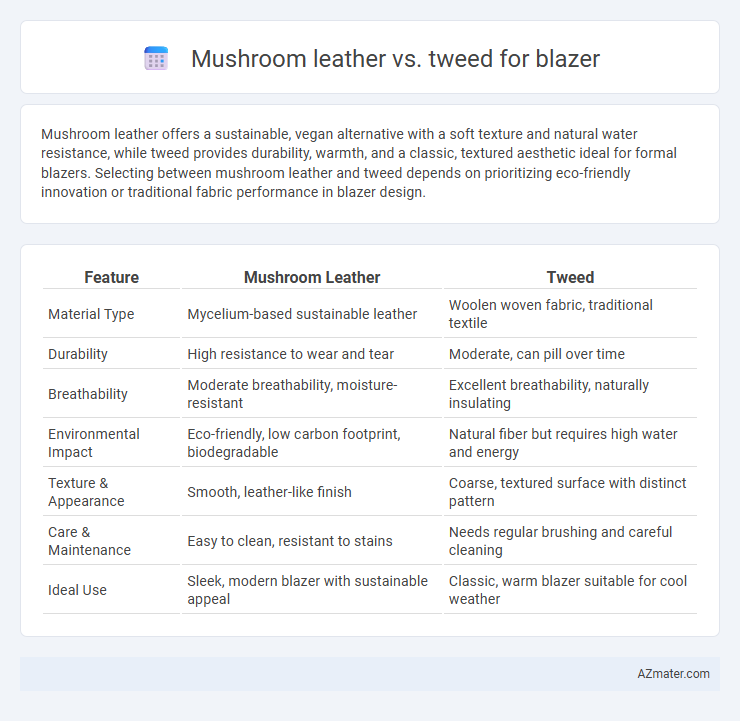Mushroom leather offers a sustainable, vegan alternative with a soft texture and natural water resistance, while tweed provides durability, warmth, and a classic, textured aesthetic ideal for formal blazers. Selecting between mushroom leather and tweed depends on prioritizing eco-friendly innovation or traditional fabric performance in blazer design.
Table of Comparison
| Feature | Mushroom Leather | Tweed |
|---|---|---|
| Material Type | Mycelium-based sustainable leather | Woolen woven fabric, traditional textile |
| Durability | High resistance to wear and tear | Moderate, can pill over time |
| Breathability | Moderate breathability, moisture-resistant | Excellent breathability, naturally insulating |
| Environmental Impact | Eco-friendly, low carbon footprint, biodegradable | Natural fiber but requires high water and energy |
| Texture & Appearance | Smooth, leather-like finish | Coarse, textured surface with distinct pattern |
| Care & Maintenance | Easy to clean, resistant to stains | Needs regular brushing and careful cleaning |
| Ideal Use | Sleek, modern blazer with sustainable appeal | Classic, warm blazer suitable for cool weather |
Introduction to Sustainable Blazer Fabrics
Mushroom leather, derived from mycelium, offers an eco-friendly alternative to traditional animal leather with its biodegradable properties and low environmental impact. Tweed, made from natural wool fibers, remains a sustainable fabric choice due to its durability and renewable source. Both materials contribute to sustainable blazer fashion by reducing reliance on synthetic textiles and promoting natural, biodegradable options.
What is Mushroom Leather?
Mushroom leather is an innovative, sustainable material derived from mycelium, the root structure of fungi, offering an eco-friendly alternative to traditional animal leather. It boasts a durable, breathable texture ideal for blazer craftsmanship, combining natural antimicrobial properties with a unique earthy aesthetic. Compared to tweed, mushroom leather provides a modern, vegan-friendly option with a sleek finish, while tweed remains favored for its classic, textured warmth and timeless style.
Understanding Tweed: Origins and Characteristics
Tweed, originating from Scotland and Ireland, is a rough, woolen fabric known for its durability and moisture resistance, making it ideal for blazers in cooler climates. Its distinctive twill weave and varied color patterns provide a classic, textured appearance that contrasts with the smooth, sustainable surface of mushroom leather. While mushroom leather offers innovative eco-friendly benefits and a sleek finish, tweed remains favored for its traditional warmth and timeless style in blazer construction.
Environmental Impact: Mushroom Leather vs Tweed
Mushroom leather, derived from mycelium, offers a sustainable alternative by utilizing agricultural waste and requiring less water and energy compared to traditional leather production. Tweed fabric is primarily made from natural wool fibers, which are renewable but involve livestock farming with higher greenhouse gas emissions and land use. Choosing mushroom leather over tweed can reduce environmental impact by lowering carbon footprint and minimizing resource consumption in blazer manufacturing.
Durability and Comfort Comparison
Mushroom leather offers excellent durability with its natural resistance to wear and tear, maintaining structural integrity over time while providing a unique, breathable texture that enhances comfort. Tweed fabric, known for its robust woolen weave, delivers superior durability against abrasion and weather elements, though it may lack the same breathability and flexibility found in mushroom leather. When prioritizing comfort, mushroom leather's soft yet resilient surface outperforms tweed's heavier and coarser feel, making it ideal for long-lasting, comfortable blazers.
Style Versatility in Blazer Design
Mushroom leather offers a sleek, modern appeal with a smooth texture that complements minimalist and contemporary blazer designs, making it ideal for urban and eco-conscious style statements. Tweed, with its rich texture and traditional pattern, enhances blazers with a classic, rustic charm, perfect for versatile layering from casual to semi-formal settings. Both materials allow designers to experiment with silhouette and detailing, but mushroom leather leans towards futuristic fashion, while tweed roots blazers firmly in timeless style versatility.
Cost and Accessibility Factors
Mushroom leather typically costs more than tweed due to its innovative biofabrication process and limited production scale, making it less accessible for mass-market blazers. Tweed remains a cost-effective and widely available option, favored for its traditional appeal and durability. Consumers seeking sustainable materials face higher price points with mushroom leather but benefit from its eco-friendly attributes, while tweed offers affordable accessibility with established supply chains.
Care and Maintenance Requirements
Mushroom leather requires gentle cleaning with a damp cloth and should be kept away from excessive moisture to maintain its texture and durability. Tweed blazers demand regular brushing to remove surface dirt and occasional professional dry cleaning to preserve fabric integrity and prevent moth damage. Both materials benefit from proper storage in a cool, dry place, but mushroom leather is more sensitive to water, whereas tweed needs protection from prolonged sunlight exposure.
Ethical Considerations and Consumer Trends
Mushroom leather, a sustainable alternative derived from mycelium, offers ethical advantages over traditional tweed by reducing reliance on animal products and minimizing environmental impact. Consumer trends increasingly favor mushroom leather for its cruelty-free production and lower carbon footprint, aligning with growing demand for eco-conscious fashion. Tweed, often associated with natural wool, raises concerns about animal welfare and resource-intensive manufacturing, prompting ethical consumers to explore innovative materials like mushroom leather in blazers.
Which Is Better for Blazers: Mushroom Leather or Tweed?
Mushroom leather offers a sustainable, vegan alternative with a smooth, modern finish and water-resistant properties, ideal for sleek, eco-conscious blazers. Tweed provides classic durability, warmth, and textured appeal, perfect for traditional, formal blazer styles in colder climates. Choosing between mushroom leather and tweed depends on desired aesthetics, climate suitability, and environmental impact preferences.

Infographic: Mushroom leather vs Tweed for Blazer
 azmater.com
azmater.com